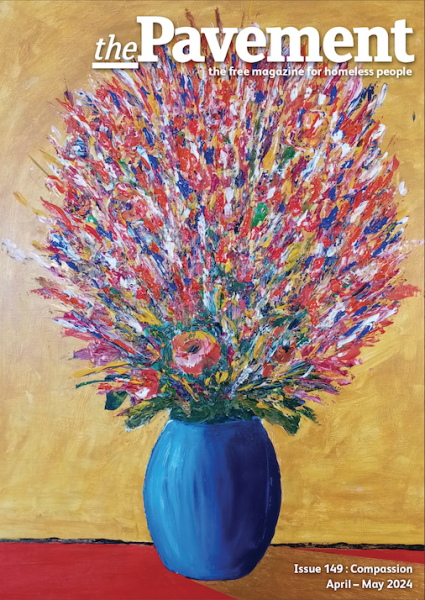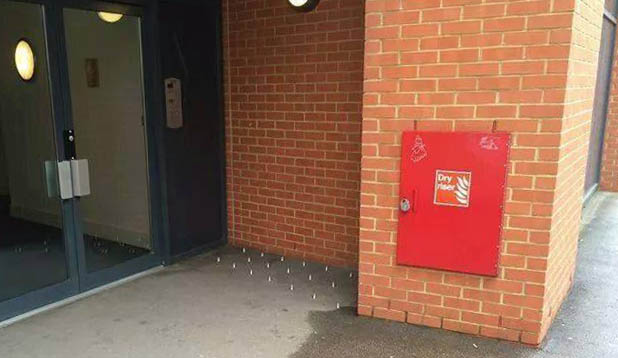
Established 2005 Registered Charity No. 1110656
Scottish Charity Register No. SC043760
DONATE
RECENT TWEETS
Public outcry ensued when anti-homeless studs were identified outside a block of flats in Southwark, a Tesco on Regent Street and a Halifax Building Society in Swansea, in early June.
Andrew Horton’s Facebook picture of the Southwark studs (19 blunt spikes, 1.5 inches high) and subsequent Twitter posts prompted a global reaction and over 100,000 re-tweets. Writing in his blog, he said: “I don’t want this to be seen as ‘socially unacceptable’. I’d like it to be ‘legally unacceptable’ as well.”
Sally Hitchiner, a well-known Anglican priest/head of department of a large multi-faith chaplaincy at Brunel University, then entered the debate on Twitter, posting the pic and tweeting: “Anti-homeless people studs outside 118 Southwark Bridge Road, London. Such a negative message!”
The mayor of London, Boris Johnson, also joined the furore, tweeting several days later: “Spikes outside Southwark housing development to deter rough sleepers are ugly, self-defeating and stupid. Developers should remove them ASAP.”
Protestors poured concrete over the Tesco’s studs and campaign group Left Unity staged a protest at the site. Bianca Todd, their principal speaker, told the Pavement: “It’s absolutely horrific to see such spikes and all it’s doing is trying to push the homeless under the carpet.
"Whilst we are pleased that Tesco removed the spikes, we want a commitment from them that they won’t reappear in other parts of the country.”
Happily, by mid-June the studs had been removed from all three sites.
Bianca identified the arms incorporated into benches that are also designed to stop rough sleeping, jet washing and other noise pollution as examples of more subtle ways of moving homeless people on. Harriet Wells, who put down a petition to ‘Remove the Anti-Homeless Spikes’ at Change.org (which attracted over 132,000 signatures), said: “I am overwhelmed at the outpouring of compassion and humanity in supporting the removal of the spikes and getting the City, the UK and the world talking about the issue of homelessness. "The spikes were simply a symbol for the way homeless people are often treated.
"They have started an important discussion that has been a long time coming and one that we need to keep having.”
City of London plans benches to 'discourage' rough sleepers
The City of London Corporation is planning to use benches designed to deter rough sleepers as part of its official plans to improve the city streets.
The plans are outlined in its ‘City Street Scene Manual’, described as "a guide to the management and improvement of the City's streets". It acts as a reference document for architects, developers and London Corporation planners.
Yet despite aspirations set out by the guide to make the street ‘accessible for all’, its section on benches says: “Timber benches should preferably be constructed from oak, with intermediate arms to assist people with disabilities and discourage rough sleepers."
"We’re really committed to reducing the number of homeless people forced to sleep rough, and we work very closely with charities." – City of London Corporation
A spokeswoman for the Corporation said that despite the concern over the spikes removed outside several city locations after they were deemed by the mayor, Boris Johnson, to be ‘ugly, self-defeating and stupid’, she knew of no plans to revisit the guide, which dates from earlier this year.
“We’re really committed to reducing the number of homeless people forced to sleep rough, and we work very closely with the charity Broadway,” she added.
Broadway, which merged with St Mungo's to form St Mungo's Broadway in May, confirmed that it works with local authorities to "make the physical environment uncomfortable for people to sleep rough", an approach that it views as ‘legitimate’ because they also work to support people to find alternatives.
In reaction to the spikes in the doorway of the Southwark housing development, Howard Sinclair, chief executive of St Mungo's Broadway, said: "Each year our teams, in Southwark and elsewhere, help thousands of people off the streets.
"Part of their role is to prevent people adopting a street lifestyle which, on occasion, means adapting the physical environment to prevent people sleeping rough in a particular location on a regular basis.
"These studs appear a rather brutal way of doing just that.”
However, with statistics published at the end of last month showing that rough sleeping is still on the rise, others called for the approach taken in the guide to be reconsidered. Katharine Sacks-Jones, head of policy and campaigns at Crisis, said: "No one should have to sleep on the streets in 21st century Britain.
"Yet over the last three years, rough sleeping has risen steeply across the country and by a massive 75 per cent in London.
"Behind these numbers are real people struggling with a lack of housing, cuts to benefits and cuts to homelessness services to help them rebuild their lives.
"They might have suffered a relationship breakdown, a bereavement or domestic abuse. They deserve better than to be forced from one place to another in search of a doorway or a bench.
"Turning our streets into hostile places for rough sleepers is not the answer. Instead we must deal with the causes." Karin Goodwin
If you are sleeping rough and want to find an alternative, you can contact Streetlink or call 0300 500 0914.
For charities and voluntary organisations which can help, see our List (insert or www. thepavement.org.uk)
April – May 2024 : Compassion
CONTENTS
BACK ISSUES
- Issue 149 : April – May 2024 : Compassion
- Issue 148 : February – March 2024 : The little things
- Issue 147 : December 2023 – January 2024 : Next steps
- Issue 146 : October 2023 – November 2023 : Kind acts
- Issue 145 : August 2023 – September 2023 : Mental health
- Issue 144 : June 2023 – July 2023 : Community
- Issue 143 : April 2023 - May 2023 : Hope springs
- Issue 142 : February 2023 - March 2023 : New Beginnings
- Issue 141 : December 2022 - January 2023 : Winter Homeless
- Issue 140 : October - November 2022 : Resolve
- Issue 139 : August - September 2022 : Creativity
- Issue 138 : June - July 2022 : Practical advice
- Issue 137 : April - May 2022 : Connection
- Issue 136 : February - March 2022 : RESPECT
- Issue 135 : Dec 2021 - Jan 2022 : OPPORTUNITY
- Issue 134 : September-October 2021 : Losses and gains
- Issue 133 : July-August 2021 : Know Your Rights
- Issue 132 : May-June 2021 : Access to Healthcare
- Issue 131 : Mar-Apr 2021 : SOLUTIONS
- Issue 130 : Jan-Feb 2021 : CHANGE
- Issue 129 : Nov-Dec 2020 : UNBELIEVABLE
- Issue 128 : Sep-Oct 2020 : COPING
- Issue 127 : Jul-Aug 2020 : HOPE
- Issue 126 : Health & Wellbeing in a Crisis
- Issue 125 : Mar-Apr 2020 : MOVING ON
- Issue 124 : Jan-Feb 2020 : STREET FOOD
- Issue 123 : Nov-Dec 2019 : HOSTELS
- Issue 122 : Sep 2019 : DEATH ON THE STREETS
- Issue 121 : July-Aug 2019 : INVISIBLE YOUTH
- Issue 120 : May-June 2019 : RECOVERY
- Issue 119 : Mar-Apr 2019 : WELLBEING
- Issue 118 : Jan-Feb 2019 : WORKING HOMELESS
- Issue 117 : Nov-Dec 2018 : HER STORY
- Issue 116 : Sept-Oct 2018 : TOILET TALK
- Issue 115 : July-Aug 2018 : HIDDEN HOMELESS
- Issue 114 : May-Jun 2018 : REBUILD YOUR LIFE
- Issue 113 : Mar–Apr 2018 : REMEMBRANCE
- Issue 112 : Jan-Feb 2018
- Issue 111 : Nov-Dec 2017
- Issue 110 : Sept-Oct 2017
- Issue 109 : July-Aug 2017
- Issue 108 : Apr-May 2017
- Issue 107 : Feb-Mar 2017
- Issue 106 : Dec 2016 - Jan 2017
- Issue 105 : Oct-Nov 2016
- Issue 104 : Aug-Sept 2016
- Issue 103 : May-June 2016
- Issue 102 : Mar-Apr 2016
- Issue 101 : Jan-Feb 2016
- Issue 100 : Nov-Dec 2015
- Issue 99 : Sept-Oct 2015
- Issue 98 : July-Aug 2015
- Issue 97 : May-Jun 2015
- Issue 96 : April 2015 [Mini Issue]
- Issue 95 : March 2015
- Issue 94 : February 2015
- Issue 93 : December 2014
- Issue 92 : November 2014
- Issue 91 : October 2014
- Issue 90 : September 2014
- Issue 89 : July 2014
- Issue 88 : June 2014
- Issue 87 : May 2014
- Issue 86 : April 2014
- Issue 85 : March 2014
- Issue 84 : February 2014
- Issue 83 : December 2013
- Issue 82 : November 2013
- Issue 81 : October 2013
- Issue 80 : September 2013
- Issue 79 : June 2013
- Issue 78 : 78
- Issue 77 : 77
- Issue 76 : 76
- Issue 75 : 75
- Issue 74 : 74
- Issue 73 : 73
- Issue 72 : 72
- Issue 71 : 71
- Issue 70 : 70
- Issue 69 : 69
- Issue 68 : 68
- Issue 67 : 67
- Issue 66 : 66
- Issue 65 : 65
- Issue 64 : 64
- Issue 63 : 63
- Issue 62 : 62
- Issue 61 : 61
- Issue 60 : 60
- Issue 59 : 59
- Issue 58 : 58
- Issue 57 : 57
- Issue 56 : 56
- Issue 56 : 56
- Issue 55 : 55
- Issue 54 : 54
- Issue 53 : 53
- Issue 52 : 52
- Issue 51 : 51
- Issue 50 : 50
- Issue 49 : 49
- Issue 48 : 48
- Issue 47 : 47
- Issue 46 : 46
- Issue 45 : 45
- Issue 44 : 44
- Issue 43 : 43
- Issue 42 : 42
- Issue 5 : 05
- Issue 4 : 04
- Issue 2 : 02
- Issue 1 : 01
- Issue 41 : 41
- Issue 40 : 40
- Issue 39 : 39
- Issue 38 : 38
- Issue 37 : 37
- Issue 36 : 36
- Issue 35 : 35
- Issue 34 : 34
- Issue 33 : 33
- Issue 10 : 10
- Issue 9 : 09
- Issue 6 : 06
- Issue 3 : 03
- Issue 32 : 32
- Issue 31 : 31
- Issue 30 : 30
- Issue 29 : 29
- Issue 11 : 11
- Issue 12 : 12
- Issue 13 : 13
- Issue 14 : 14
- Issue 15 : 15
- Issue 16 : 16
- Issue 17 : 17
- Issue 18 : 18
- Issue 19 : 19
- Issue 20 : 20
- Issue 21 : 21
- Issue 22 : 22
- Issue 23 : 23
- Issue 24 : 24
- Issue 25 : 25
- Issue 8 : 08
- Issue 7 : 07
- Issue 26 : 26
- Issue 27 : 27
- Issue 28 : 28
- Issue 1 : 01

